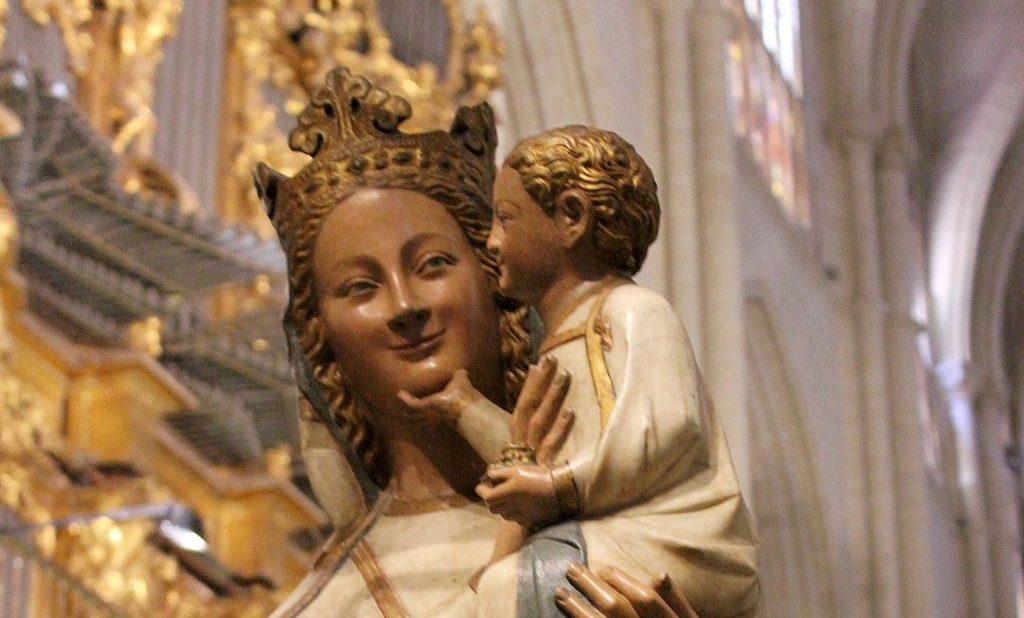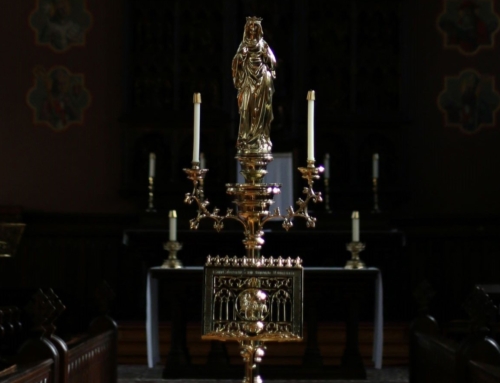Mothers have a certain smile. We see its unique power when a mother bends down and smiles at her baby, her captivated child staring back wide-eyed. Enveloped in the warmth of that maternal love, the baby’s whole attention rests upon his mother’s smile. Babies appear most at peace beneath their mothers’ smiles. Some studies even suggest that infants try to incite their mothers to smile.
As it is with our earthly mothers, so it is with our heavenly mother. At the foot of the cross, Our Lord gave us his mother, the Mother of God (c.f. John 19:26–27), who now, from heaven, smiles down on all her children.
The French spiritual writer, Father Pierre Descouvemont, characterizes true devotion to Mary primarily as “getting into the habit of living under the smile of Mary” (translated from Marie au coeur de nos vies by Pierre Descouvemont, 25–26). Stories from the lives of two famous saints of the nineteenth century illustrate the joy of living under Our Lady’s smile.
As a young child, Saint Thérèse of Lisieux fell seriously ill. With her feverish state worsening, Thérèse’s family grew more distraught. In anguish, her sisters knelt before a statue of Our Lady, begging for her help. Thérèse too, turned to her Mother and asked for her merciful pity.
Suddenly, Thérèse saw the statue’s visage transfigured, displaying a heavenly beauty and tenderness. But, she recalled, “what cut me to the depth of the soul was her ravishing smile” (translated from Histoire d’une Âme by Thérèse of Lisieux, 56–57). And in the light of that smile all her pains vanished.
Twenty-five years earlier, that same smile shook the soul of another young French girl. On February 11, 1858, Bernadette Soubirous was collecting firewood when she suddenly saw a beautiful woman. The woman did not speak but only smiled at her. Again, during the second appearance, the woman smiled without speaking. The soul of the young saint was forever transfixed by this smile, overflowing with heavenly love.
One day, the Count of Bruissard, a debauchee and an atheist, hearing of Bernadette’s supposed apparitions of the Blessed Virgin, drove to Lourdes to expose her as a liar. Having listened to her story, he asked her to reproduce Mary’s smile. At first, Bernadette responded that one would need to be in heaven to reproduce that smile. Learning, however, that the Count was an unbeliever and hardened sinner, precisely the type the Virgin had told her to pray for, she replicated the smile.
When he looked at the face of the peasant girl, the Count saw imprinted there a vision of that heavenly smile.That smile was etched into the deepest recesses of his heart. As he wrote later in life, “Since then, I carry in me, in the depths of my soul, that divine smile. It has dried many tears. I lost my wife and my two daughters, but it seems to me that I am not alone in the world. I live with the smile of the Virgin” (translated from La merveilleuse vie de Bernadette: la voyante de Lourdes by Xavier Marchet, 164–166).
That maternal smile converted the Count and carried him through the many sorrows of this life. He learned to live beneath Mary’s smile. Bernadette, too, retired to a convent to contemplate the love she had experienced.
Why did that smile heal Thérèse, save the Count, and leave Bernadette transfixed?
We find the answer in Dante’s Paradiso. Approaching the pinnacle of his celestial pilgrimage, Dante at last gazes into the face of Mary. The poet, as if prefiguring Bernadette’s words, can but say, “That all the wondrous things I’d seen before had not so left my vision stunned, suspended, nor shown me so much of the face of God” (Paradiso, XXXII, 91–93).
The smile of our Mother shows us the face of her Son. In Mary’s smile, they glimpsed something of divine love. Looking into the face of the one who gave God a human face, they saw reflected the love of God become incarnate.
Merely a glimpse of a reflection of God’s love was enough to heal a sick child, obliterate the hardened atheism of an arrogant sinner, and draw Bernadette into the silence of the cloister, there to spend her days always contemplating that love.
And it was only a glimpse. Had Thérèse and Bernadette seen the fullness of that love, Descouvemont says, “they would have died of happiness.” Only in heaven will we see completely “with what infinite love we are loved by God, by the Virgin Mary and by all the saints of Paradise. But these two girls of France perceived something from the smile of Mary and they were shaken by it.”
Live, then, under the smile of Mary and be shaken thereby.
✠
Image: Virgen Blanca de Toledo. Photo by Miguel Hermoso Cuesta (CC BY-SA 4.0)







